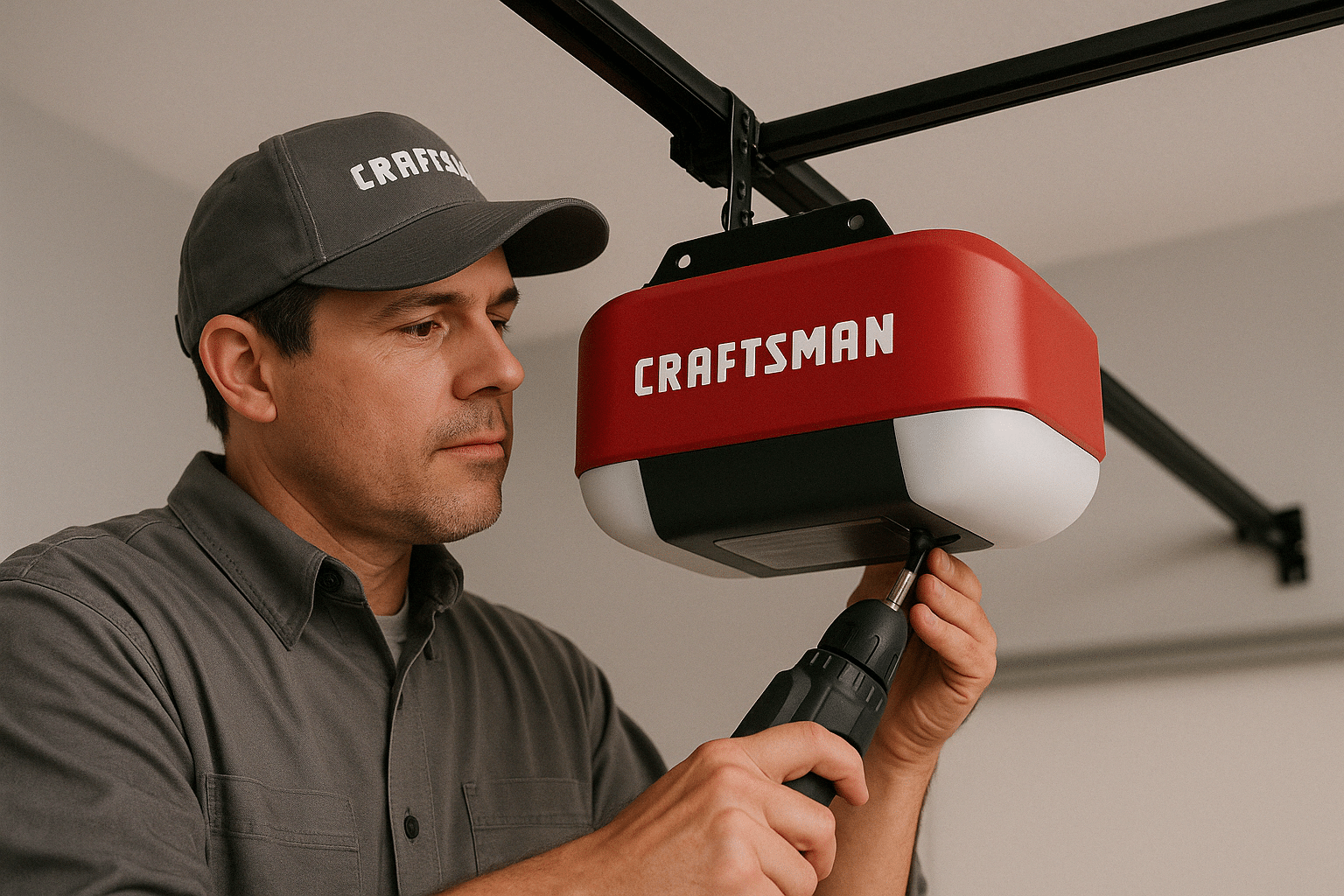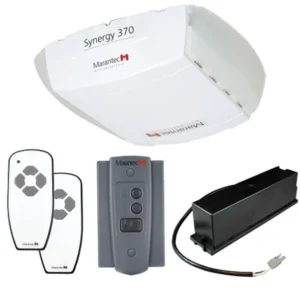Topics Covered:
Over the years, Craftsman garage door openers have found their way into countless garages across the country, thanks to the brand’s reputation for durable tools and appliances. At RJ Garage Door Services, we’ve serviced and installed many Craftsman units, from older chain-drive systems to modern belt-drive models with smartphone connectivity. While Craftsman openers are generally reliable, no mechanical device is immune to wear and tear.
Worn or Broken Drive Belts and Chains
One of the most common problems we see involves the drive mechanism—particularly in older Craftsman models. Chain-drive openers, while robust, can develop slack or rust over time. Belt-drive systems offer quieter operation, but their belts can wear down and sometimes snap. The first sign of trouble may be an unusual rattling or grinding sound, or a sudden inability for the door to move. A DIY fix typically involves examining the chain or belt for visible damage and adjusting tension according to Craftsman’s guidelines. However, if the chain is severely rusted or the belt is frayed, replacement is often necessary. We recommend using Craftsman-approved replacement parts for optimal performance.
Stripped Gears
If your opener motor runs but the door doesn’t budge, you might be dealing with stripped gears in the motor assembly. This issue is particularly common in high-usage settings or if the door isn’t well balanced. The gears that connect the motor shaft to the drive mechanism can gradually lose their teeth, rendering them ineffective. Some homeowners are comfortable replacing these gears themselves, but the process can be a bit involved. You’ll need to remove the opener’s housing, extract the old gears, and carefully install the new ones with the correct alignment. If you’re not confident in your mechanical skills, RJ Garage Door Services can handle the repair and also inspect why the gears failed in the first place.
Remote and Keypad Malfunctions
Craftsman openers typically come with wireless remotes and occasionally a keypad. Over time, remotes can stop working due to dead batteries, internal circuitry failures, or issues with radio interference. The simplest first step is to replace the batteries. If that doesn’t work, try reprogramming the remote by following the steps in your owner’s manual. For keypads, worn-out buttons can cause erratic behavior. Additionally, exposure to the elements can degrade the keypad’s internal components. If reprogramming and battery replacement fail, the device might need replacement. At RJ Garage Door Services, we keep universal remotes and keypads on hand so we can quickly address such issues.
Sensor Alignment and Sensor Failure
Like most modern openers, Craftsman units rely on safety sensors at the base of the door’s track. If these sensors are misaligned or covered with dust, the door may refuse to close or might reverse unexpectedly. Regularly inspect the sensor lenses for dirt or cobwebs. Check the alignment by observing the LED lights; they should remain steady when the sensors are facing each other correctly. In some cases, a damaged wire or faulty sensor could be the culprit. Replacing the sensors is typically straightforward if you’re comfortable handling basic wiring, but a professional can ensure proper installation and confirm that no deeper electrical problem exists in the opener’s circuit board.
Motor Overheating and Unexpected Shutdowns
If your garage door opener runs for a bit and then abruptly stops, you might be encountering motor overheating. Craftsman motors are equipped with thermal overload protectors, which shut down the unit to prevent permanent damage. Overheating can occur if the door is unusually heavy, the springs are unbalanced, or you’re operating the door repeatedly in a short period of time. First, give the motor time to cool down and try again. If the issue persists, investigate whether your door hardware—springs, rollers, and hinges—is creating excessive resistance. A tune-up from RJ Garage Door Services can identify whether you need spring adjustments or roller replacements to reduce motor strain.
Loud or Jerky Operation
Any opener can become loud or rough over time. Chain-drive Craftsman models in particular can rattle if the chain is loose or the sprocket assembly is worn. Belt-drive models might squeak if the belt tension changes or the belt material degrades. Additionally, worn rollers on the garage door track can amplify noise. Try lubricating the door’s hinges and rollers with a high-quality garage door lubricant, and check that all bolts and fasteners on the opener assembly are tight. If you still experience loud noises or jerky motion, it may be time for a more thorough inspection to ensure alignment and track stability.
Electrical Board and Logic Problems
Inside every Craftsman opener is a logic board that governs how the unit operates. Power surges, manufacturing defects, or normal wear can occasionally cause these boards to fail. Symptoms might include unresponsive remotes, random opening/closing cycles, or erratic light flashing on the opener. While homeowners may attempt to replace the logic board themselves (it often involves swapping a circuit module), diagnosing whether the board is indeed the issue can be tricky. At RJ Garage Door Services, we use diagnostic tools to confirm the board is failing, and we always check for simpler issues first—like faulty wiring or a malfunctioning wall switch.
DIY Fixes vs. Calling a Professional
Many Craftsman garage door opener problems can be addressed by homeowners who feel comfortable working with mechanical parts and basic wiring. Replacing batteries, cleaning sensors, and tightening chains or belts are often safe beginner tasks. However, more advanced issues—like changing torsion springs, overhauling gears, or diagnosing electrical problems—pose significant safety risks if not done correctly. Springs are under intense tension and can cause serious injury if released improperly. Before attempting a major repair, consider your skill level and available tools. RJ Garage Door Services is here to handle complex repairs, ensuring everything is done to code and with minimal risk to you.
Preventive Maintenance for Long-Term Performance
Preventive maintenance is your best defense against common opener failures. At least once a year, thoroughly inspect your Craftsman opener for loose bolts, worn parts, and unusual noises. Lubricate moving parts according to Craftsman’s guidelines and verify that door components—springs, rollers, cables—are in good condition. If you’re unsure what to look for, scheduling an annual tune-up with us is a simple way to keep your opener running smoothly. We’ll also update firmware if your Craftsman model supports that, and we’ll recommend part replacements before they become urgent.
Conclusion
Craftsman garage door openers combine durability with user-friendly designs, but even the most reliable models can experience issues over time. From worn drive belts and stripped gears to sensor misalignment and electrical board failures, there’s a range of potential problems that might arise. Fortunately, many of these can be tackled with basic DIY methods—like replacing remote batteries, adjusting chain tension, or cleaning the sensors. When more serious issues surface, such as a broken torsion spring or a consistently overheating motor, professional intervention ensures safety and preserves your opener’s longevity.
At RJ Garage Door Services, we believe in helping you make informed decisions that balance cost, convenience, and safety. Whether you’re dealing with a minor hiccup or a major breakdown, you can count on us to provide honest, expert assistance that keeps your Craftsman opener running at its best.




